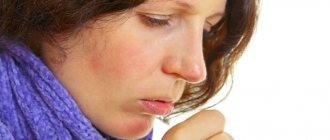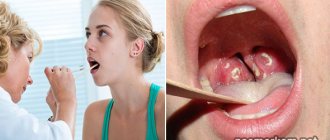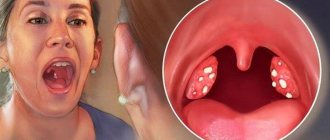1.General information
It would seem that any person who has had a runny nose at least once is familiar with this uncomfortable sensation: somewhere in the depths of the nasopharynx, something has accumulated and interferes with every swallow, and it is necessary to get rid of it urgently, by any means... Considering that a runny nose is the most common from painful human conditions, we can safely assume: this feeling of “internal runny nose” is known to everyone, and it is known so well that there seems to be nothing to talk about here. In the end, the mucous membranes of the nasopharynx normally produce large volumes of secretion, some of which flows down the back wall, is swallowed with saliva and food, sometimes accumulates - for example, after a night's sleep - but, in general, does not create any special problems.
However, the flow of moisturizing and bactericidal mucus along the posterior nasopharyngeal wall into the laryngopharynx is not always “normal” and problem-free. It's all about the causes of hypersecretion, the composition and properties of mucus, and its quantity.
Rhinitis (runny nose) and accompanying rhinorrhea (profuse discharge of mucous discharge from the nasal passages) is, by and large, not a disease. This is a symptom, a sign of a particular pathology. Sometimes this symptom is quite expected and really does not have any particular clinical significance, but in some cases it requires special attention and examination. For such cases, a special term has been introduced, which is found in the literature in several synonymous spellings: postnasal drip syndrome (English: “postnasal drip syndrom”), retronasal drip (sometimes written “drip”), retronasal discharge, internal runny nose, postnasal syndrome. It was first described at the end of the 18th century under the name “chronic pharyngeal catarrh.”
A must read! Help with treatment and hospitalization!
Methods for getting rid of sticky mucus
After making a diagnosis, the doctor prescribes the optimal treatment. Usually, if the sputum does not clear for a long time, is accompanied by a sore throat or chest, or fever, complex therapy is prescribed. Treatment is carried out with antibiotic, antimycotic, anti-inflammatory, antiseptic, and analgesic medications.
Most often, doctors recommend throat sprays to patients:
- Bioparox,
- Givalex,
- Orasept,
- Cameton.
These medications are intended for the treatment of pharyngitis, laryngitis, tonsillitis, and infectious rhinitis. They are easy to use: you just need to hold your breath and spray the medicine into your mouth.
With rhinopharyngitis, sputum accumulates in the throat and deep parts of the nasal cavity. From the nose, mucous clots often penetrate the throat, causing irritation of the walls and intense coughing. How to get rid of sticky mucus and ease a cough? The first method is regular expectoration. It is also recommended for a sick person to:
- gargle;
- do inhalations;
- rinse your nose;
- drink enough water;
- maintain optimal temperature and humidity in the home.
2. Reasons
Possible causes of hypersecretion of nasal mucus are very numerous and varied:
- acute respiratory viral infections (ARVI);
- rhinitis of allergic etiology;
- sinusitis (inflammation of the paranasal sinuses);
- foreign bodies in the nasal cavity (more common in childhood);
- long-term use of hormone-containing contraceptives, antihypertensive drugs and drugs of some other groups;
- congenital or acquired anomalies of the anatomical structure (most often a deviated nasal septum);
- adenoiditis (inflammation of hyperplastic growths of lymphoid glandular tissue);
- vasomotor rhinitis (hypersensitivity to changes in temperature, humidity, etc.);
- food allergies or ingestion of spicy, sour or other irritating foods;
- air pollution with irritants (substances or particles that irritate the mucous membrane).
In the absence of the above reasons, postnasal drip can be observed in women during gestation (so-called rhinitis of pregnant women) and in patients with gastroesophageal reflux.
Visit our Otolaryngology (ENT) page
When is medical help needed?
Many people try to get rid of sticky mucus in their throat on their own. Treatment at home is usually not difficult. But if the following symptoms appear, you should immediately go to the doctor.
- Body temperature is above 38°C. This is a signal about the development of the inflammatory process.
- Chills. Pain in joint and muscle tissues.
- Sputum and cough lasting longer than two weeks.
- The presence of blood streaks and pus in the mucus.
- Disruption of the gastrointestinal tract. Sour taste of saliva in mouth.
- Pain in the chest area. This is how pneumonia can manifest itself.
- Intense pain in the head.
3. Symptoms and diagnosis
In addition to the interfering sensation described above, a feeling of congestion and an increased swallowing (and sometimes gag) reflex designed to “clear the throat,” retronasal drip is one of the causes of chronic cough, since excess amounts of mucus, flowing into the laryngopharynx, mechanically irritate the cough receptors. Often there is also pain in the tonsils and/or pharynx, a “lump in the throat” due to reflex swelling, and in more severe cases – dysphonia, hoarseness, and symptoms of salpingootitis.
As a rule, with an upright position of the body, the symptoms are significantly alleviated, and when lying down, especially for a long time, they worsen.
Diagnostics includes the study of complaints and medical history, a detailed examination of the ENT organs, as well as, as necessary, the use of additional research methods (endoscopic, tomographic, laboratory, etc.). In some cases, consultation with specialized specialists is necessary, for example, an allergist, an infectious disease specialist, etc.
Differential diagnosis is carried out with chronic bronchitis and other clinically similar conditions.
About our clinic Chistye Prudy metro station Medintercom page!
About mucus in the throat
Mucus in the throat occurs due to the abundant accumulation of phlegm.
Mucus in the throat can accumulate under the influence of various factors associated with both the external environment and diseases of the internal organs. The most common cause of mucus in the throat is diseases of the ENT organs of allergic, non-allergic, as well as bacterial, post-infectious and fungal origin. Abnormalities in the development of the nasopharynx can contribute to the development of mucus in the throat.
Persons who have excessive accumulation of mucus in the throat should be observed by an ENT doctor, since the real cause of this phenomenon is not easy to determine. The main thing is not to self-medicate, so as not to worsen the situation. Mucus in the throat can appear for various reasons. Quite often, mucus in the throat occurs due to abundant accumulation of sputum , which is the first sign of an inflammatory process in the bronchi. To make an accurate diagnosis, you need to consult a medical specialist, that is, an ENT specialist.
A characteristic sign of one of the diseases in which mucus appears in the throat is catarrhal or hypertrophic pharyngitis of a chronic nature. In this case, the inflammation that affects the pharynx area leads to the formation of a lump of mucus, which irritates the mucous membrane, causing the desire to cough.
4.Treatment
Depending on the diagnostic results obtained, etiotropic therapy is prescribed, i.e. measures are taken to eliminate the root cause of retronasal drip. In some cases, the primary goal is desensitization and relief of allergic inflammation (solved with medication and by minimizing contact with allergens), in others it is impossible to do without surgical restoration of normal anatomy, patency, ventilation and drainage of the nasal passages, in others, one or another strategy for the treatment of sinusitis is used , gastroenterological treatment, a course of physiotherapy, etc. are prescribed.
It is important to understand that constant and abundant flow of mucus down the back wall of the throat is not normal; this condition requires specialist consultation, examination and treatment. Effective assistance is provided in all cases.
Treatment of mucus in the throat
Treatment of mucus in the throat at the ENT-Asthma clinic is comprehensive and is aimed at suppressing local symptoms of the disease, affecting the main causes that maintain mucus in the throat. The main task of treating mucus in the throat is to eliminate discomfort. For more effective treatment, painkillers and anti-inflammatory, antiseptic and antibacterial drugs are used.
For local treatment of mucus in the throat, drugs can be used to help moisturize the mucous membrane and relieve sensations that are considered paresthesia - a feeling of soreness and tickling in the throat. In cases where mucus in the throat is a symptom of an infectious disease , atomization of the pharyngeal cavity is used using aerosols of combined action (antiseptic and analgesic). The choice of an antibacterial agent by an ENT doctor largely depends on the identified pathogen in case of moderate and severe course of the disease.
If the mucus in the throat is of an allergic nature, then our specialist doctors use a complex of antihistamines. To treat mucus in the throat, the ENT-Asthma clinic uses immunomodulators , which stimulate the body’s own forces to fight the disease. Simply put, the desired result is achieved by increasing immunity. To effectively treat mucus in the throat, sanitation of foci of infection, the oral cavity and the upper respiratory tract is indicated.
How to rinse your nose?
To rinse the nose, decoctions of sage, chamomile, lavender, St. John's wort or saline solution are used.
- To prepare a saline solution, dissolve 2 grams of sea or table salt in a glass of warm water. The same salt concentration is characteristic of blood plasma, which is why the solution is called physiological.
- To rinse your nose, drop 3 drops of medicinal liquid into each nostril.
- Then you need to blow your nose thoroughly so that the liquefied sputum and remaining solution are removed from the nasal cavity. In a small child, mucus from the nose after the procedure can be removed using a nasal aspirator or a cotton tube.
- A cotton tube is moistened with a soda solution and inserted shallowly into the nostril. When the baby sneezes, the tube is removed, covered in mucus.
You can also inhale a saline solution to loosen sticky sputum. The solution is poured into a convenient container. A man leans over the sink and inhales medicinal liquid from a container. After inhaling, the head should not be raised, otherwise the solution will not flow out of the nose, but will pour into the lower respiratory tract.
The head can be raised only after the fluid has completely drained from the nose. Rinsing can also be done using a syringe. A man leans over the sink and turns his head to the side.
The medicine is squeezed out of the syringe into the upper nostril and flows out of the lower nostril. This method of treatment allows you to quickly liquefy mucus and remove it from the respiratory tract.
How to gargle?
For the procedures, decoctions of medicinal plants are used, which have a vasoconstrictor and antiseptic effect. Gargling has a beneficial effect on the mucous membranes of the throat, eliminates cough, and removes unpleasant odor from the mouth. Treatment promotes intensive expectoration of mucus from the throat. It is advisable to rinse up to five times a day. It is recommended to use the following products as medicinal solutions.
- Infusion of medicinal herbs. Take 2 tablespoons of a suitable medicinal plant: mint, sage, calendula, chamomile, eucalyptus or celandine. The plant material is poured with a liter of boiling water and infused.
- Decoction of onion peels. Take 3 teaspoons of husk. Boil in a liter of water for 30 minutes.
- Apple vinegar. A teaspoon of vinegar is diluted in a glass of warm water.
- Clay solution. A teaspoon of green clay dissolves in a glass of warm water.
- Iodine-soda solution. Add 3 drops of iodine and half a teaspoon of baking soda to a glass of saline solution.
- Cranberry juice. Add a tablespoon of honey to a glass of cranberry juice.
What is sputum
© Hank Grebe/Getty Images
Our body produces mucus that coats certain ducts, such as the respiratory and digestive tracts, to protect and maintain certain functions.
This mucus prevents bacteria and viruses from causing infection.
Moreover, our body produces about a liter of phlegm every day.
Most often we don't notice it, but when the mucus becomes thick and takes on an unusual color, such as yellow, green or brown, it can become a problem.
How to carry out inhalations?
- To get rid of phlegm in the throat and cough, it is recommended to do 20-minute inhalations based on the above medicinal plants. To eliminate the symptoms of colds, it is useful to breathe sea salt steam. For the procedure, you need to dissolve a teaspoon of salt in 0.5 liters of boiling water.
- To loosen mucus clots and stimulate coughing, you can inhale steam from boiled potatoes. The mucus thins, the cough stops, and the unpleasant odor in the mouth disappears when inhalations based on eucalyptus or juniper essential oils are carried out. For the procedure, 15 drops of essential oil are dissolved in a glass of boiling water.








